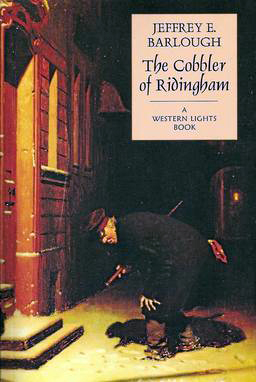New Treasures: The Cobbler of Ridingham by Jeffrey E. Barlough
 Winter is the best time to appreciate Jeffrey E. Barlough, perhaps none more so than the current brutality we’ve been experiencing in New England. Day after day of snow blowing past the windows makes it easy to imagine oneself in Barlough’s alternate history of an ice age that never fully receded; and a fire in the grate and a cup of hot coffee at hand while the wind howls beyond the lattices blurs the distinction between this reality and living in a separate megafauna-filled America settled by Victorian doomsday survivors swaddled in coats and mufflers.
Winter is the best time to appreciate Jeffrey E. Barlough, perhaps none more so than the current brutality we’ve been experiencing in New England. Day after day of snow blowing past the windows makes it easy to imagine oneself in Barlough’s alternate history of an ice age that never fully receded; and a fire in the grate and a cup of hot coffee at hand while the wind howls beyond the lattices blurs the distinction between this reality and living in a separate megafauna-filled America settled by Victorian doomsday survivors swaddled in coats and mufflers.
In Barlough’s latest novel, The Cobbler of Ridingham, Richard Hathaway comes to Haigh Hall to examine some letters penned by Pharnaby Crust, an overlooked composer whom Hathaway intends to rescue from obscurity with a thorough biography. While studying in the Hall’s library, Hathaway observes a lurking shadow without source and is soon immersed in the curse of Crispin Nightshade, the infamous cobbler of nearby Ridingham. Nightshade used something known as haunted leather to fashion shoes which, when placed on the feet of corpses, could make the dead walk again. There are bumps in the night, unexplained footprints, a boot found in a snow bank, and more, all involving Barlough’s typical cast of well-sketched characters from upstairs and down.
Cobbler is Barlough’s eighth book in his Western Lights series. His last three offerings have largely abandoned the dark menace of his earlier works: A Tangle in Slops was light Shakespearean comedy, A Midsummer’s Night Dream mix-up involving ancient druidesses, water nymphs, and mylodons; while What I Found at Hoole was a kind of English countryside mystery set in the mountains instead of upon the moors. I much prefer Barlough’s more Gothic novels, and yet there’s something cozy and comforting about these latest. Each book stands alone but long-time readers will recognize names and developments from earlier installments; just as Hoole worked as a sort-of sequel to Anchorwick, here Cobbler operates as an addendum to the third book, Strange Cargo. And though while reading I often wished something truly dreadful would happen to the characters (remember when our hero was sucked into the clock in Anchorwick? I sure do!), at the same time it’s very gratifying to periodically revisit and, for a time, inhabit Barlough’s post-apocalyptic world. Having closed the covers on book number eight, I cannot wait for book number nine, or ten, or eleven.
I’ve complained before about the lack of appreciation for Barlough among steampunk readers; and with steampunk having clearly ossified into its self-parody of prostitutes whose hearts of gold beat beneath their corsets and airships, airships, AIRSHIPS, I suppose mine is a lost cause. But I think there’s another group poised to discover Barlough because the Western Lights is a landscape waiting to be overrun by RPGers, and Cobbler is a perfect example of what they can expect to find. There is an antiquarian uncovering dark secrets; there are magical artifacts, spirits and predators, and ruins explored. Men ride through marshes, cutlasses and poignards at their belts as protection against saber cats and spotted lions, and on the far side await walled towns of Tudor inns and overhanging gables. There are petty nobles and estates and while presumably the lands of the Western Lights were once a constitutional monarchy, having lost contact with said monarch since the Sundering, they have defaulted to the self-sufficiency of the frontier. Gamers looking for a unique setting will discover a great deal of material to mine.
The Cobber of Ridingham is available in paperback from Gresham & Doyle. On a related note: The House in the High Wood, the second book in the series, is now available for Kindle, though the price isn’t that much different than that of the hard copy. Even though the first three books were published by Ace, the other members of the triplet are still not available as e-books.
[…] that’s our own Jackson Kuhl in the TOC. Jackson’s last article for us was his review of Jeffrey E. Barlough’s The Cobbler of Ridingham, which appeared here last week. On his […]